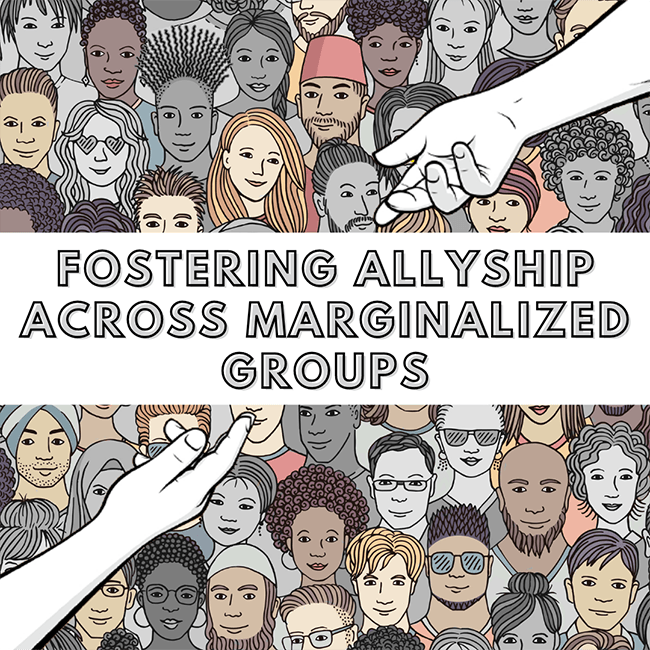
Support for the Black community doesn't end once Black History Month ends. Allyship is actionable but is not performative, meaning you shouldn't be an ally for the recognition or awards. Each of us can practice allyship, even if you are a member of a marginalized group. We each have some degree of benefit or access to resources that some groups may not have; therefore, can advocate for and provide access to resources to those who need it the most. Here are some things to keep in mind as we continue to be actionable allies.
Be open to learning. As an ally, it is crucial first to understand the underlying reasons and factors that may be contributing to the oppression or systemic inequalities that the Black community faces. Next, it's essential to learn about how you can advocate for and support those who don't have a voice. Learn about microaggressions, cultural competence, and how to be inclusive to different groups, which leads me to the next key point.
Be inclusive. Different marginalized groups require different things to feel included. Be aware of things like gendered terms and use language that embraces diverse groups of people.
Black people aren't a monolith. Black community members have many different identities that simultaneously interconnect (LGBTQ, disabilities, women, Hispanic, Asian, and Native American). Therefore, it's important to keep in mind the historical events afflicting those in the Black community.
The EDI Special Emphasis Portfolio Strategists provided some tips on how members of the Black community can serve as allies to different marginalized communities and how each of the populations aligned with their portfolios can serve as allies to the Black community.
Principal Strategist for the Asian Americans & Pacific Islander Portfolio, Caroline Goon said:
"Recently, one of my main realizations is that our experiences dealing with inequalities within our society are not merely individual, but that it is different manifestations of a broken system. Taking a stand for the Black community sends a message that while the same structures that keep our communities down may look different in Black and Asian communities, it is still the same system – one where we cannot write our own stories. The COVID-19 pandemic may have initiated our community to feel personally endangered by racism. Still, our vulnerability should instead motivate us to reach out – to others in our sphere of influence, and beyond it – so that we can thoughtfully advocate for justice."
Resources 1 and 2 to learn more.
Principal Strategist for the Hispanic Portfolio, Gerard Roman said:
"A key aspect of allyship is the support from individuals that recognize the power of diversity and inclusion. Support begins by listening deeply to those around you, building solidarity, and learning more about the issues and the history of the struggles that hinder D&I progress. Solidarity allows us to root-out inequities and helps us embrace our differences. Becoming an inclusive ally starts with simple, actionable behaviors such as calling out inappropriate conduct, using inclusive language, recognizing privilege, and amplifying the marginalized and underrepresented voice. Progress is made when various groups work together to form alliances and work together to achieve our D&I goals faster and more efficiently. Being an ally is beyond being sympathetic towards marginalized individuals. It is more than just believing in equity. Being an ally means acting in pursuit of ending oppression and creating equity and inclusion for all."
Principal Strategist for the Native American Portfolio, Ashley Wells said:
"Allyship means acknowledging your privilege and building trust with the American Indians and Alaska Natives to help empower those without a voice. It's important to listen to the Native community and help amplify their voices instead of speaking on their behalf. The American Indian and Alaska Native community can help support the Black community by finding common interests and celebrating their unique histories. They share the struggle against dispossession in the United States, which has negatively impacted both communities. The ability to engage in open and honest dialogue is the first step in becoming an ally. People also have to reflect on actions they are accountable for that's contributing to any injustice."
Principal Strategist for the People with Disabilities Portfolio, David Rice said:
"Allyship for People with Disabilities ranges from being supportive towards an individual as well as being part of the larger disability rights movement. You can achieve this by becoming more educated about the laws that protect People with Disabilities and recognize that our disability is not who we are, just a part of our identity. Working side by side with allies can help amplify our voices without overshadowing us. The Americans with Disabilities ACT (ADA) was such an important law that was first passed in 1990. The passage of the law would not have been possible without the Civil Rights Act of 1964. The two laws coexist in ensuring that we move forward together as a community within the D&I space. Let's progress forward together!"
Principal Strategist for the Sexual & Gender Minority Portfolio, Bali White said:
"Given that LGBT people make up a small percentage of the population, yet alone most workplaces, allies are critical in creating a welcoming and inclusive workplace. Not only do allies help foster safety in the coming-out process, but doing things like using someone's preferred pronouns correctly, can also help others understand the importance of equality, fairness, acceptance, and mutual respect. It's important also to recognize that some members of the LGBTQ community are Black and face oppression for being Black and because they are a member of the LGBTQ community. The level of oppression increases as it relates to the Black trans community. Your voice is critical to fostering the acceptance of LGBT people in our workspaces. Speak out now and show the world the importance of accepting our LGBT co-workers and anyone else who may be different than ourselves."
Resources 1 and 2 to learn more.
Principal Strategist for the Women's Portfolio, Joy Postell said:
"For the women's portfolio, allyship requires transparency around equal pay and growth opportunities. The NIH Women's Portfolio encompasses the needs of all women, including Black women. While Black women are not monolithic in their thoughts and experiences, they have a unique history in this country. They can be overlooked based on unfounded beliefs and biases rather than their intellect or abilities. Black women are worthy of support, opportunity, and acknowledgment, despite the historical and continuous practice of building on their backs and benefitting from their innovative contributions without adequate compensation or recognition. Black women want what most women want; to be treated fairly, with dignity and respect, with the untethered freedom to communicate their unique perspectives, without fear of retaliation, belittling, or dismissiveness. If one is uncomfortable speaking up on behalf of Black women as an ally, at the very least, leave the door cracked, clear the aisle, quiet the room so that they might make their way to the microphone to be rightfully seen and heard."
Do you have a story idea for us? Do you want to submit a guest blog? If it's about equity, diversity, or inclusion, please submit to edi.stories@nih.gov.
For news, updates, and videos, follow or subscribe to EDI on: Twitter, Instagram, Blog, YouTube.






